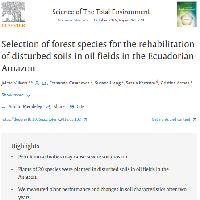Resumen
-
Soils in the Amazon Basin disturbed by petroleum extraction activities need to be restored to allow for the rehabilitation of these areas and the restoration of the ecosystem services that they can provide. This study explores the performance of saplings of 20 species transplanted to four sites: a paddock and three sites within oil fields that differ in soil substrate contamination and perturbation. In each site we measured sapling survival, possible causes of death, sapling height and diameter at the time of and two years after planting, and the integrated response index. We also analyzed the effects of plants on soil properties. Sapling mortality was limited, with 17 of the 20 species boasting survival rates of over 80%. Saplings in the control site had a higher mortality rate than those in the oil field sites. This was most likely due to competition with and interference of weeds that were more abundant at the control than other sites. Despite the overall low mortality rate, species performance did vary by site, with plants of Flemingia macrophylla, Myrcia aff. fallax, Piptadenia pteroclada, Platymiscium pinnatum, and Zygia longifolia exhibiting the best performance in terms of survival and growth in oil field sites. At the end of the experiment, soil substrates from the oil platform showed increases in pH levels, organic material, Fe, and Zn; whereas substrates contaminated with petroleum showed decreases in hydrocarbon levels ranging from 11 to 22% compared to initial levels before sapling transplanting. Our results shed light on which forest species are most suitable for the rehabilitation of sites disturbed by activities inherently associated with petroleum extraction in the Ecuadorian Amazon.
